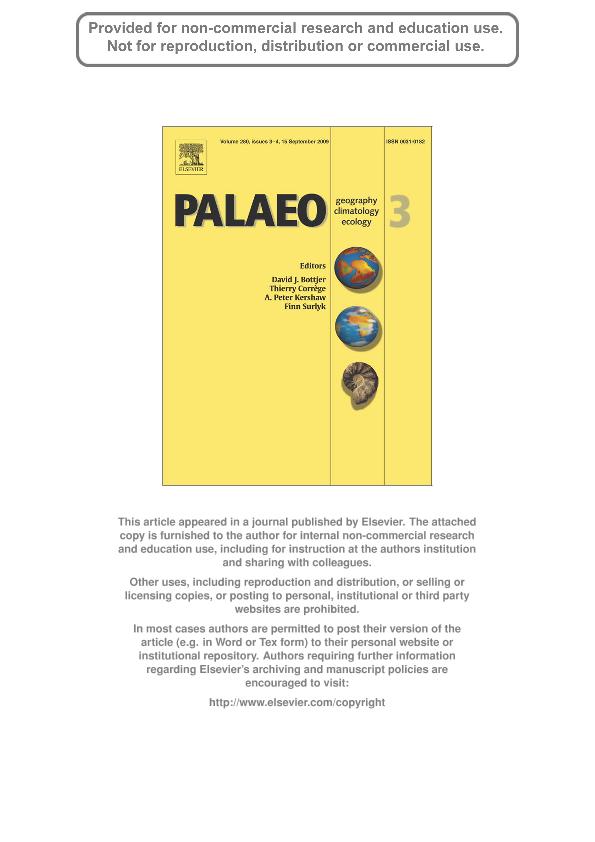Mostrar el registro sencillo del ítem
dc.contributor.author
Prevosti, Francisco Juan

dc.contributor.author
Pardiñas, Ulises Francisco J.

dc.date.available
2020-01-13T14:10:47Z
dc.date.issued
2009-09
dc.identifier.citation
Prevosti, Francisco Juan; Pardiñas, Ulises Francisco J.; Comment on “The oldest South American Cricetidae (Rodentia) and Mustelidae (Carnivora): Late Miocene faunal turnover in central Argentina and the Great American Biotic Interchange” by D.H. Verzi and C.I. Montalvo [Palaeogeography, Palaeoclimatology, Palaeoecology 267 (2008) 284–291]; Elsevier Science; Palaeogeography, Palaeoclimatology, Palaeoecology; 280; 3-4; 9-2009; 543-547
dc.identifier.issn
0031-0182
dc.identifier.uri
http://hdl.handle.net/11336/94480
dc.description.abstract
In a recent paper (Verzi, D.H., Montalvo, C.I., 2008. The oldest South American Cricetidae (Rodentia) and Mustelidae (Carnivora): late Miocene faunal turnover in central Argentina and the Great American Biotic Interchange. Palaeogeography, Palaeoclimatology, Palaeoecology 267, 284–291) the potentially oldest South American Cricetidae (Rodentia) and Mustelidae (Carnivora) have been reported from a Late Miocene (Huayquerian) assemblage located in central Argentina (Caleufú site, La Pampa province). These findings expand the biochron of these important families in South America 3–4 Ma earlier than previous records. However, several observations prevent us from accepting the validity of these assumptions. In this paper we discuss the age of the Caleufú assemblage, and the assignment of the GHUNLPam 21722 to Mustelidae. The Caleufú assemblage contains a mixture of Pliocene and Late Miocene faunal elements, and has been assigned to the Huayquerian only due to the “stage of evolution” of some rodents. The lack of isotopic or paleomagnetic data coupled with the isolation of this locality and the absence of a local stratigraphic succession inhibit its correlation with other palaeontological comparable sites and a robust inference about its chronology. The “stage of evolution” of a taxon is not a biostratigraphic tool, thus we cannot rule out the possibility that the Caleufú assemblage has an Early Pliocene (Montehermosan) age. The GHUNLPam 21722, a poorly preserved specimen, shows several characters (e.g., 4 lower incisors, mental foramina below the incisors absent, third lower incisor smaller than the first and second ones) that do not match with Mustelidae (or Carnivora) but instead strongly resemble those observed in didelphimorphian marsupials. The discussed caveats regarding Caleufu assemblage chronology and taxonomy indicate that new and detailed studies are needed before the hypotheses advanced by Verzi and Montalvo can be accepted.
dc.format
application/pdf
dc.language.iso
eng
dc.publisher
Elsevier Science

dc.rights
info:eu-repo/semantics/openAccess
dc.rights.uri
https://creativecommons.org/licenses/by-nc-sa/2.5/ar/
dc.subject
CRICETIDAE
dc.subject
DIDELPHIMORPHIA
dc.subject
GREAT AMERICAN BIOTIC INTERCHANGE
dc.subject
LATE MIOCENE
dc.subject
SOUTH AMERICA
dc.subject.classification
Paleontología

dc.subject.classification
Ciencias de la Tierra y relacionadas con el Medio Ambiente

dc.subject.classification
CIENCIAS NATURALES Y EXACTAS

dc.title
Comment on “The oldest South American Cricetidae (Rodentia) and Mustelidae (Carnivora): Late Miocene faunal turnover in central Argentina and the Great American Biotic Interchange” by D.H. Verzi and C.I. Montalvo [Palaeogeography, Palaeoclimatology, Palaeoecology 267 (2008) 284–291]
dc.type
info:eu-repo/semantics/article
dc.type
info:ar-repo/semantics/artículo
dc.type
info:eu-repo/semantics/publishedVersion
dc.date.updated
2019-12-12T14:49:53Z
dc.journal.volume
280
dc.journal.number
3-4
dc.journal.pagination
543-547
dc.journal.pais
Países Bajos

dc.journal.ciudad
Amsterdam
dc.description.fil
Fil: Prevosti, Francisco Juan. Consejo Nacional de Investigaciones Científicas y Técnicas. Oficina de Coordinación Administrativa Parque Centenario. Museo Argentino de Ciencias Naturales “Bernardino Rivadavia”; Argentina
dc.description.fil
Fil: Pardiñas, Ulises Francisco J.. Consejo Nacional de Investigaciones Científicas y Técnicas. Centro Nacional Patagónico; Argentina
dc.journal.title
Palaeogeography, Palaeoclimatology, Palaeoecology

dc.relation.alternativeid
info:eu-repo/semantics/altIdentifier/url/https://www.sciencedirect.com/science/article/pii/S0031018209002570
dc.relation.alternativeid
info:eu-repo/semantics/altIdentifier/doi/http://dx.doi.org/10.1016/j.palaeo.2009.05.021
Archivos asociados
